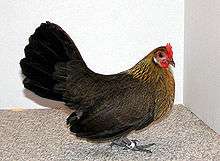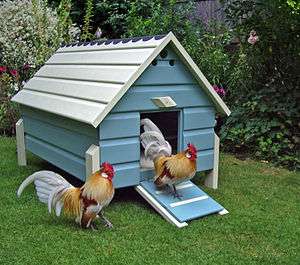Dutch Bantam
 Dutch Bantam pullet | |
| Conservation status | Common |
|---|---|
| Other names | Dutch: Hollandse Kriel |
| Country of origin | the Netherlands |
| Standard | |
| Traits | |
| Weight | Male: 550 grams |
| Female: 450 grams | |
| Skin color | white |
| Egg color | light brown |
| Comb type | single with 5 points |
| Classification | |
| ABA | single comb clean legged[1] |
| PCGB | true bantam[2] |
|
Chicken Gallus gallus domesticus | |
The Dutch Bantam (Dutch: Hollandse Kriel) is a breed of chicken originating in the Netherlands. It is also one of the true bantam breeds, meaning it is a naturally small bird with no related large fowl from which it was miniaturized.[3] Dutch Bantams have many color variations, and have grown in popularity as exhibition poultry worldwide.
Dutch bantams are also practical chickens, being especially hardy, good layers for their size. They are desirable family pets due to their reputation for thriving on loving care and easy keeping in confined space.[4]
History
Diminutive chickens of similar coloration to today's Dutch Bantams have been seen in the Netherlands for hundreds of years, but the exact origin of the breed is unclear. It is likely that the ancestors of the Dutch Bantam were Southeast Asian bantams brought back by sailors from the Dutch East Indies.[5] Historically, it is supposed that these tiny chickens were selectively bred because only small eggs could be kept by peasant farmers, while larger ones were required to be sent to the kitchens of the landed gentry.[5] The first written referring to Dutch Bantam (as a distinct breed) is from a Hague zoo record dated to 1882, and the Dutch Poultry Club recognized the breed by 1906.[3]
The first transatlantic export of Dutch Bantams was to the United States after World War II; they were first shown in the country in the early 1950s. This initial overseas population died out due to lack of interest from breeders, and the next exportation, to both the United Kingdom and the United States, was not until the 1970s. The British Dutch Bantam Club was formed in 1982, and 14 colors are standardized. The American Poultry Association accepted the breed in the show ring in 1992, and the Standard of Perfection describes ten color varieties.[6]
To this day the Dutch remains one of the most popular breeds in its home country the Netherlands, has a well-established number of breeders in the UK and Germany, and is quickly gaining popularity in South Africa and the United States.[4]
Characteristics
Dutch Bantams are one of the smallest breeds of bantam, and are one of the true bantams. Males should weigh no more than 550 grams, and females 450 grams. Due to their light weight and relatively large wings, Dutch Bantams fly rather well. The original type of plumage for Dutch Bantams was a partridge pattern. Today, there are dozens of colors including: Gold Partridge (black-red), Silver Partridge (silver duckwing), Yellow Partridge (yellow duckwing), Red Shouldered White (Pyle), Black and many more. All varieties should have a comb with 5 points, white earlobes, slate blue legs, apart from certain varieties and white skin.
The breed is friendly in temperament, but somewhat flighty. Their small size and comb type makes them not especially cold hardy. Dutch Bantam hens make good mothers and will easily go broody. Uniquely for bantams, and especially ones popular in showing, Dutch Bantams lay well; they can produce 160 cream or white eggs in a year, though the size of the egg is much smaller than commercial layers. Due to their friendly character and egg laying ability, the breed is well suited to hobbyists and backyard keepers needing a bantam sized bird.[7]

Notes
- ↑ APA Recognized Breeds and Varieties as of January 1, 2012. American Poultry Association. Accessed August 2014.
- ↑ Breed Classification. Poultry Club of Great Britain. Accessed August 2014.
- 1 2 Graham, p. 136
- 1 2 Hobson, Jeremy and Lewis, Celia. Choosing & Raising Chickens: The complete guide to breeds and welfare. David & Charles Publishing. London. 2009. Page 45.
- 1 2 Ekarius, p. 119
- ↑ Ekarius, p. 120
- ↑ Jeremy Hobson and Celia Lewis. Choosing & Raising Chickens: The complete guide to breeds and welfare. David and Charles publishing. London. 2009
References
- Ekarius, Carol (2007). Storey's Illustrated Guide to Poultry Breeds. 210 MAS MoCA Way, North Adams MA 01247: Storey Publishing. ISBN 978-1-58017-667-5.
- Graham, Chris (2006). Choosing and Keeping Chickens. 2-4 Heron Quays London E14 4JP: Octopus Publishing. ISBN 978-0-7938-0601-0.
External links
- Hollandse Krielenfokkers Club (in Dutch)
